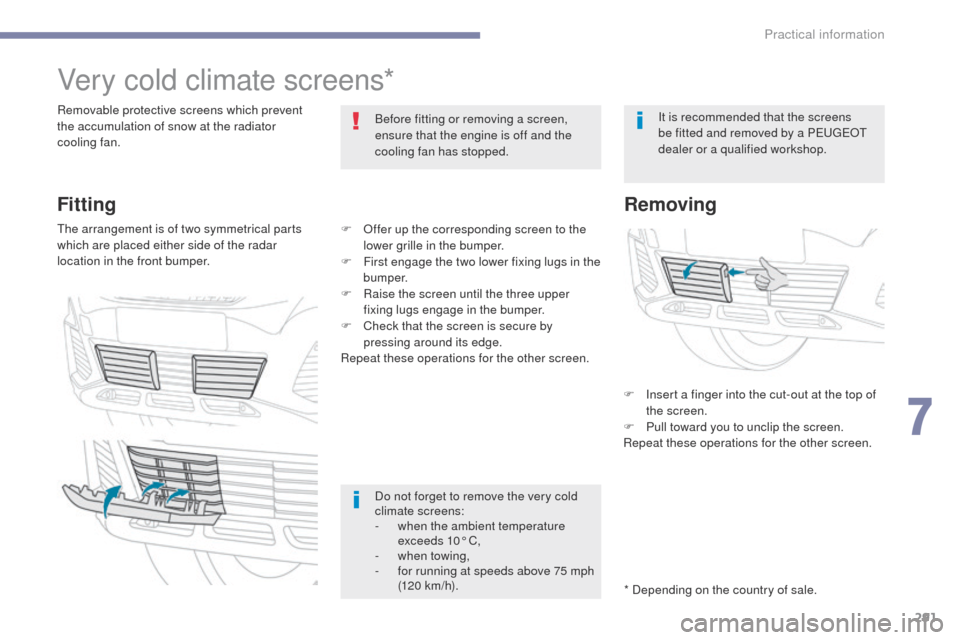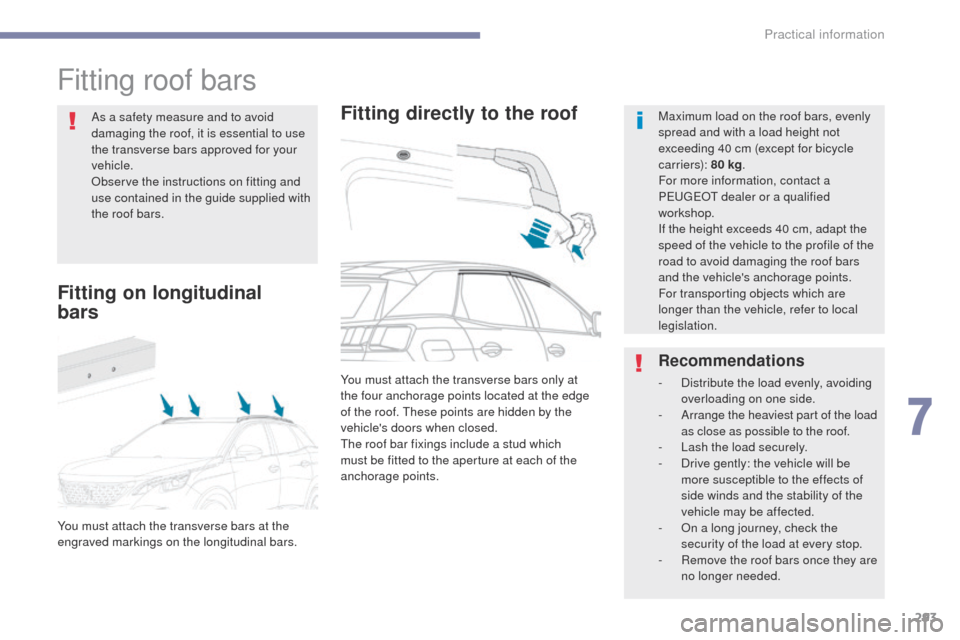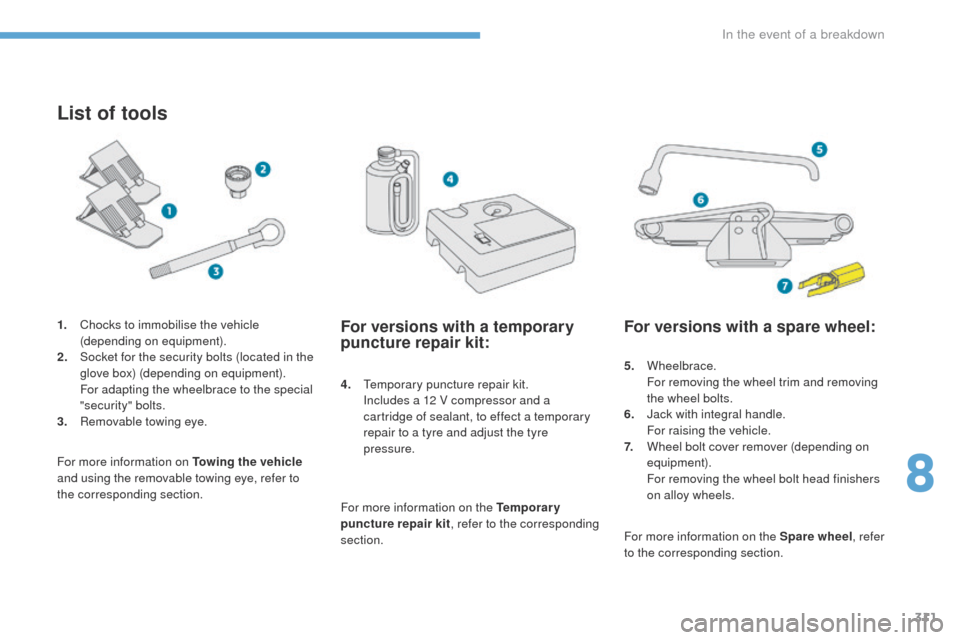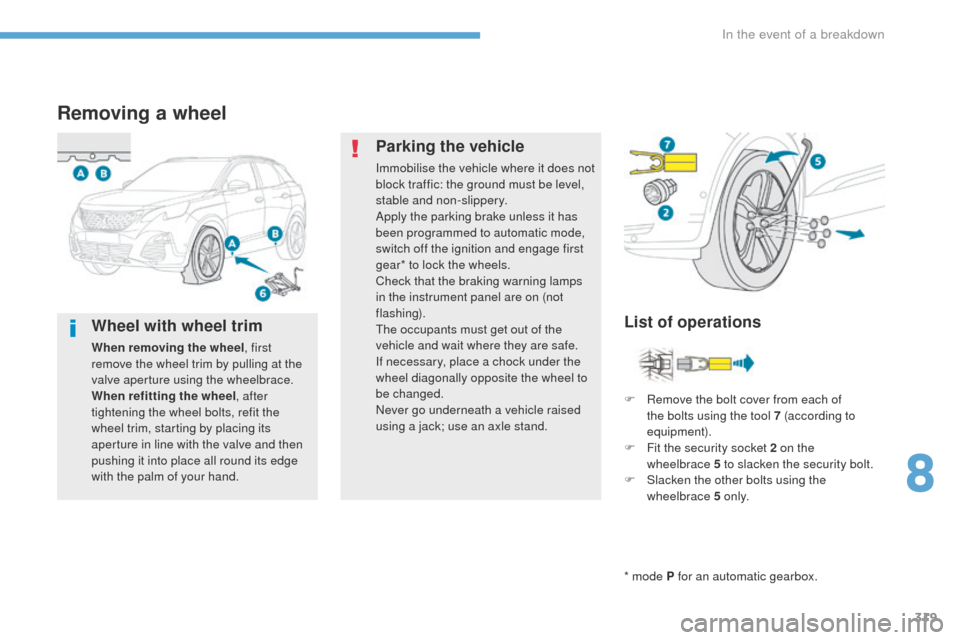Page 293 of 566

291
3008-2_en_Chap07_infos-pratiques_ed01-2016
Very cold climate screens*
Removable protective screens which prevent
the accumulation of snow at the radiator
cooling fan.Before fitting or removing a screen,
ensure that the engine is off and the
cooling fan has stopped.
* Depending on the country of sale.It is recommended that the screens
be fitted and removed by a PEUGEOT
dealer or a qualified workshop.
Fitting
The arrangement is of two symmetrical parts
which are placed either side of the radar
location in the front bumper.
Removing
F Insert a finger into the cut-out at the top of
the screen.
F
P
ull toward you to unclip the screen.
Repeat these operations for the other screen.
Do not forget to remove the very cold
climate screens:
-
w
hen the ambient temperature
exceeds 10° C,
-
w
hen towing,
-
f
or running at speeds above 75 mph
(120 km/h).
F
O
ffer up the corresponding screen to the
lower grille in the bumper.
F
F
irst engage the two lower fixing lugs in the
b u m p e r.
F
R
aise the screen until the three upper
fixing lugs engage in the bumper.
F
C
heck that the screen is secure by
pressing around its edge.
Repeat these operations for the other screen.
7
Practical information
Page 295 of 566

293
3008-2_en_Chap07_infos-pratiques_ed01-2016
Fitting roof bars
Fitting directly to the roofMaximum load on the roof bars, evenly
spread and with a load height not
exceeding 40 cm (except for bicycle
c a r r i e r s): 80 kg.
For more information, contact a
PEUGEOT dealer or a qualified
workshop.
If the height exceeds 40 cm, adapt the
speed of the vehicle to the profile of the
road to avoid damaging the roof bars
and the vehicle's anchorage points.
For transporting objects which are
longer than the vehicle, refer to local
legislation.
Recommendations
- Distribute the load evenly, avoiding overloading on one side.
-
A
rrange the heaviest part of the load
as close as possible to the roof.
-
L
ash the load securely.
-
D
rive gently: the vehicle will be
more susceptible to the effects of
side winds and the stability of the
vehicle may be affected.
-
O
n a long journey, check the
security of the load at every stop.
-
R
emove the roof bars once they are
no longer needed.
As a safety measure and to avoid
damaging the roof, it is essential to use
the transverse bars approved for your
vehicle.
Observe the instructions on fitting and
use contained in the guide supplied with
the roof bars.
You must attach the transverse bars only at
the four anchorage points located at the edge
of the roof. These points are hidden by the
vehicle's doors when closed.
The roof bar fixings include a stud which
must be fitted to the aperture at each of the
anchorage points.
Fitting on longitudinal
bars
You must attach the transverse bars at the
engraved markings on the longitudinal bars.
7
Practical information
Page 313 of 566

311
3008-2_en_Chap08_en cas-de-panne_ed01-2016
List of tools
4. Temporary puncture repair kit. Includes a 12 V compressor and a
cartridge of sealant, to effect a temporary
repair to a tyre and adjust the tyre
pressure.
For more information on Towing the vehicle
and using the removable towing eye, refer to
the corresponding section. 1.
C
hocks to immobilise the vehicle
(depending on equipment).
2.
S
ocket for the security bolts (located in the
glove box) (depending on equipment). F
or adapting the wheelbrace to the special
"security" bolts.
3.
R
emovable towing eye.
For versions with a temporary
puncture repair kit:
For more information on the Temporary
puncture repair kit , refer to the corresponding
section.
For versions with a spare wheel:
5. Wheelbrace. F
or removing the wheel trim and removing
the wheel bolts.
6.
J
ack with integral handle.
F
or raising the vehicle.
7.
W
heel bolt cover remover (depending on
equipment).
F
or removing the wheel bolt head finishers
on alloy wheels.
For more information on the Spare wheel , refer
to the corresponding section.
8
In the event of a breakdown
Page 314 of 566
312
3008-2_en_Chap08_en cas-de-panne_ed01-2016
Temporary puncture repair kit
Comprising a compressor and a sealant
cartridge, it allows the temporary repair of
a tyre so that you can drive to the nearest
garage.
It is designed to repair most punctures which
could affect the tyre, located on the tyre tread
or shoulder.Composition of the kit
1. 12 V compressor, with integral pressure gauge.
2.
S
ealant cartridge, with integral hose.
3.
Spe
ed limit sticker. The speed limit sticker must be secured
to the interior of the vehicle in the
driver's field of vision, to remind you
that a wheel is in temporary use.
Do not exceed a speed of 50 mph
(80
km/h) when driving with a tyre
repaired using this type of kit.
The vehicle's electric system allows the
connection of the compressor for long
enough to inflate a tyre after a puncture
repair.
In the event of a breakdown
Page 315 of 566
313
3008-2_en_Chap08_en cas-de-panne_ed01-2016
Repair procedure
F Switch off the ignition.
F S ecure the speed limit sticker inside the
vehicle.
Avoid removing any foreign bodies
which have penetrated into the tyre.
F
U
ncoil the pipe stowed under the
compressor.
F
C
onnect the pipe from the compressor to
the sealant cartridge. F
R emove the valve cap from the tyre to be
repaired, and place it in a clean area.
F
C
onnect the hose from the sealant
cartridge to the valve of the tyre to be
repaired and tighten firmly.
F
T urn the sealant cartridge and secure it in
the cut-out provided on the compressor.
8
In the event of a breakdown
Page 321 of 566

319
3008-2_en_Chap08_en cas-de-panne_ed01-2016
Removing a wheel
* mode P for an automatic gearbox.
List of operations
Parking the vehicle
Immobilise the vehicle where it does not
block traffic: the ground must be level,
stable and non-slippery.
Apply the parking brake unless it has
been programmed to automatic mode,
switch off the ignition and engage first
gear* to lock the wheels.
Check that the braking warning lamps
in the instrument panel are on (not
flashing).
The occupants must get out of the
vehicle and wait where they are safe.
If necessary, place a chock under the
wheel diagonally opposite the wheel to
be changed.
Never go underneath a vehicle raised
using a jack; use an axle stand.
F
R
emove the bolt cover from each of
the bolts using the tool 7 (according to
equipment).
F
F
it the security socket 2 on the
wheelbrace
5 to slacken the security bolt.
F
S
lacken the other bolts using the
wheelbrace 5 o n l y.
Wheel with wheel trim
When removing the wheel , first
remove the wheel trim by pulling at the
valve aperture using the wheelbrace.
When refitting the wheel , after
tightening the wheel bolts, refit the
wheel trim, starting by placing its
aperture in line with the valve and then
pushing it into place all round its edge
with the palm of your hand.
8
In the event of a breakdown
Page 323 of 566
321
3008-2_en_Chap08_en cas-de-panne_ed01-2016
List of operations
F Put the wheel in place on the hub.
F S crew in the bolts by hand to the stop.
F
P
re-tighten the security bolt using the
wheelbrace 5 fitted with the security
socket
2.
F
P
re-tighten the other bolts using the
wheelbrace 5 o n l y.
F
L
ower the vehicle fully.
F
F
old the jack 6 and detach it.
Fitting a wheel
Fitting a steel or "space-
saver" spare wheel
If your vehicle is fitted with alloy wheels,
when tightening the bolts on fitting it is
normal to notice that the washers do
not come into contact with the steel or
"space-saver" spare wheel. The wheel
is secured by the conical contact of
each bolt.
8
In the event of a breakdown
Page 324 of 566
322
3008-2_en_Chap08_en cas-de-panne_ed01-2016
F Tighten the other bolts using the wheelbrace 5 o n l y.
F
R
efit the bolt covers to the bolts (according
to equipment).
F
S
tore the tools.
F
T
ighten the security bolt using the
wheelbrace 5 fitted with the security
socket
2 .
After changing a wheel
To store the punctured wheel in the
boot correctly, first remove the central
c ove r.
When using the "space-saver" type
spare wheel, do not exceed 50 mph
(80
km/h).
Have the tightening of the bolts and the
pressure of the spare wheel checked
by a PEUGEOT dealer or a qualified
workshop without delay.
Have the punctured wheel repaired and
replace it on the vehicle as soon as
possible.
In the event of a breakdown